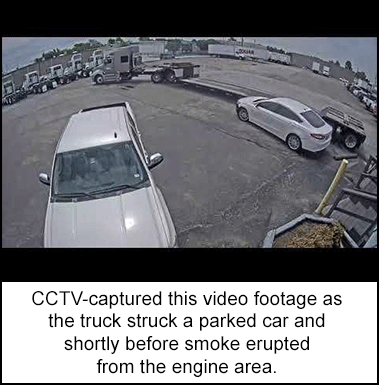-
What happened?
Shortly after a fuel leak on a semi-trailer truck was repaired at a dealership, the driver noticed it was leaking again.
While en route to the dealership to get it fixed, the driver was unaware that fuel was leaking on the exhaust manifold.
The driver was overcome as the A/C system pumped carbon monoxide from the burning fuel into the cabin and struck a parked car in the dealership parking lot.
This event could have had serious and even fatal implications. The driver was unable to walk without falling and had nearly lost the ability to speak. The driver was taken to the hospital by ambulance and remained there for 12 hours.

-
Why did it happen?
The A/C system pumped carbon monoxide from the burning fuel into the truck cabin with the driver inside.
The driver did not realize the degree of incapacitation until the attempt to exit the truck and the individual recognized at what degree the motor functions were diminished.
The individual believed themselves having a medical episode of some sort and never suspected carbon monoxide.

-
What did they learn?
- When the truck was backed up after striking the parked car, smoke erupted from the hood indicating significant problems with the engine.
- Pre-trip inspections should include checking for fluid leaks as well as exhaust leaks. Exhaust leaks are often signified by soot at or near a connection.
- The vehicle was taken out of service as per the Commercial Vehicle Safety Alliance (CVSA) – 2020 North American Standard Out-of-Service Criteria (OOSC) inspection. This standard identifies critical safety violations that stipulate a vehicle be taken out of service until the condition or violation is corrected or repaired.
- If an individual recognizes he/she is experiencing a medical episode, it is vitally important to safely pull the vehicle over, stop and seek aid, either by calling 9-1-1 or an area-specific emergency number.

-
Ask yourself or your crew
- How can something like this happen here (e.g. on our site)?
- What safety measures (i.e. procedures, controls/barriers) do we have in place to mitigate the risk?
- How do we know the risk controls/barriers are working?
- What improvements or changes should we make to the procedures, controls/barriers or the way we work?

Add to homescreen
Content name
Select existing category:
Content name
New collection
Edit collection
What happened?
Shortly after a fuel leak on a semi-trailer truck was repaired at a dealership, the driver noticed it was leaking again.
While en route to the dealership to get it fixed, the driver was unaware that fuel was leaking on the exhaust manifold.
The driver was overcome as the A/C system pumped carbon monoxide from the burning fuel into the cabin and struck a parked car in the dealership parking lot.
This event could have had serious and even fatal implications. The driver was unable to walk without falling and had nearly lost the ability to speak. The driver was taken to the hospital by ambulance and remained there for 12 hours.

Why did it happen?
The A/C system pumped carbon monoxide from the burning fuel into the truck cabin with the driver inside.
The driver did not realize the degree of incapacitation until the attempt to exit the truck and the individual recognized at what degree the motor functions were diminished.
The individual believed themselves having a medical episode of some sort and never suspected carbon monoxide.
What did they learn?
- When the truck was backed up after striking the parked car, smoke erupted from the hood indicating significant problems with the engine.
- Pre-trip inspections should include checking for fluid leaks as well as exhaust leaks. Exhaust leaks are often signified by soot at or near a connection.
- The vehicle was taken out of service as per the Commercial Vehicle Safety Alliance (CVSA) – 2020 North American Standard Out-of-Service Criteria (OOSC) inspection. This standard identifies critical safety violations that stipulate a vehicle be taken out of service until the condition or violation is corrected or repaired.
- If an individual recognizes he/she is experiencing a medical episode, it is vitally important to safely pull the vehicle over, stop and seek aid, either by calling 9-1-1 or an area-specific emergency number.
Ask yourself or your crew
- How can something like this happen here (e.g. on our site)?
- What safety measures (i.e. procedures, controls/barriers) do we have in place to mitigate the risk?
- How do we know the risk controls/barriers are working?
- What improvements or changes should we make to the procedures, controls/barriers or the way we work?
Shortly after a fuel leak on a semi-trailer truck was repaired at a dealership, the driver noticed it was leaking again. On the way to the dealership to get it fixed, the driver was unaware that fuel was leaking on the exhaust manifold. The air conditioning system pumped carbon monoxide from the burning fuel into the cabin, incapacitating the driver.
Original material courtesy of Energy Safety Canada

Other resources:
Government of Canada: Air Quality and Health
CVSA’s New 2020 North America Standard Out-of-Service Criteria









